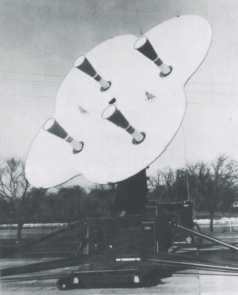4-11
Figure 4-12.—Parabolic antenna cluster.
Receivers
All satellite communications earth terminals are equipped with specially designed, highly sensitive
receivers. These receivers are designed to overcome down-link power losses and to permit extraction of
the desired communications information from the weak received signal. The terminals currently in use
have specially designed preamplifiers mounted directly behind the antennas.
Transmitters
All earth terminal transmitters generate high-power signals for transmission to the communications
satellites. High-powered transmitters and highly directional, high-gain antennas are combined in this
configuration. This is necessary to overcome up-link limitations and to ensure that the signals received by
the satellite are strong enough to be detected by the satellite. Each transmitter has an exciter/modulator
and a power amplifier. The modulator accepts the input signal from the terminal equipment and
modulates an IF carrier. The exciter translates the IF signal to the up-link frequency and amplifies it to the
level required by the power amplifier.
Transmitters used in earth terminals have output power capabilities that vary from 10 watts to 20
kilowatts, depending on the type used and the operational requirements.
Telemetry Equipment
Telemetry equipment is included in all communications satellite systems. This permits monitoring of
the operating conditions within the satellite. Telemetry can be used also for remote control of satellite
operations, such as energizing axial jets for changing the spin axis of the satellite.
Q7. What type of antennas are generally used at earth terminals?
Q8. Why do earth terminals require highly sensitive receivers?
Q9. What is the range of earth terminal transmitter output power?

